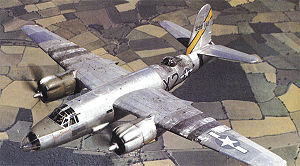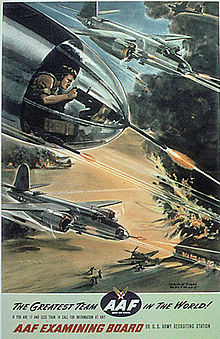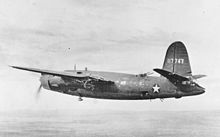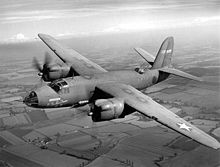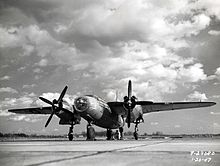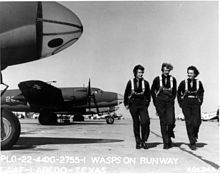- Martin B-26 Marauder
-
Not to be confused with Douglas A-26 Invader.
B-26 Marauder A US Army Air Forces B-26B with D-Day invasion stripes Role Medium bomber National origin United States Manufacturer Glenn L. Martin Company First flight 25 November 1940 Introduction 1941 Status Retired Primary users United States Army Air Forces
United States Army Air Corps
Royal Air Force
South African Air ForceProduced 1941–1945 Number built 5,288[1] [N 1] Unit cost $102,659.33/B-26A[2] Developed into XB-33 Super Marauder (Unbuilt) The Martin B-26 Marauder was a World War II twin-engine medium bomber built by the Glenn L. Martin Company. First used in the Pacific Theater in early 1942, it was also used in the Mediterranean Theater and in Western Europe.
After entering service with the U.S. Army, the aircraft received the reputation of a "Widowmaker" due to the early models' high rate of accidents during takeoff and landings. The Marauder had to be flown by exact airspeeds, particularly on final approach and when one engine was out. The 150 mph (241 km/h) speed on short final was intimidating to pilots who were used to much slower speeds, and whenever they slowed down below what the manual stated, the aircraft would stall and crash.[3]
The B-26 became a safer aircraft once crews were re-trained and after aerodynamics modifications (increase of wing span and incidence, to give better take off performance, and a larger fin and rudder).[4] After aerodynamic and design changes, the aircraft distinguished itself as "the chief bombardment weapon on the Western Front" according to a United States Army Air Forces dispatch from 1946.[citation needed] The Marauder ended World War II with the lowest loss rate of any USAAF bomber.[5]
A total of 5,288 were produced between February 1941 and March 1945; 522 of these were flown by the Royal Air Force and the South African Air Force. By the time the United States Air Force was created as an independent service separate from the Army in 1947, all Martin B-26s had been retired from US service. The Douglas A-26 Invader then assumed the B-26 designation.
Contents
Design and development
In March 1939, the United States Army Air Corps issued Circular Proposal 39-640, a specification for a twin-engined medium bomber, demanding a maximum speed of 350 mph (560 km/h), a range of 3,000 mi (4,800 km) and a bomb load of 2,000 lb (910 kg). On 5 July 1939, the Glenn L. Martin Company submitted its design, produced by a team led by Peyton M. Magruder, to meet the requirement, the Martin Model 179. Martin's design was evaluated as superior to the other proposals and was awarded a contract for 201 aircraft, to be designated B-26.[6] The B-26 went from paper concept to an operational bomber in approximately two years.[7] Additional orders for a further 930 B-26s followed in September 1940, still prior to the first flight of the type.[8]
The B-26 was a shoulder-winged monoplane of all metal construction, fitted with a tricycle undercarriage. It had a streamlined, circular section fuselage, housing the crew, consisting of a bombardier in the nose, which was armed with a .30 in (7.62 mm) machine gun, a pilot and co-pilot sitting side by side, with positions for radio operator and navigator behind the pilots. A gunner manned a dorsal turret armed with two .50 in (12.7 mm) machine guns (the first powered dorsal turret to be fitted to a US bomber), while an additional .30 in (7.62 mm) machine gun was fitted in the tail.[N 2]
Two bomb bays were fitted mid-fuselage, capable of carrying 5,800 lb (2,600 kg) of bombs, although in practice such a bombload reduced range too much, and the aft bomb bay was usually fitted with additional fuel tanks instead of bombs. It was powered by two Pratt & Whitney R-2800 Double Wasp radial engines in nacelles slung under the wing, driving four-bladed propellers. The engines were manufactured at the Ford Dearborn Engine plant in Dearborn, MI, USA. The wings were of low aspect ratio and relatively small area for an aircraft of its weight, giving the required high performance, but also resulting in a wing loading of 53 lb/sq ft (259 kg/m²) for the initial versions, which at the time was the highest of any aircraft accepted for service by the Army Air Force.[10]
The first B-26, with Martin test pilot William K. "Ken" Ebel at the controls, flew on 25 November 1940 and was effectively the prototype. Deliveries to the U.S. Army Air Corps began in February 1941 with the second aircraft, 40-1362.[8] In March 1941, the Army Air Corps started Accelerated Service Testing of the B-26 at Patterson Field, Ohio.
Accidents
While the B-26 was a fast aircraft with better performance than the contemporary North American B-25 Mitchell, its relatively small wing area and resulting high wing loading (the highest of any aircraft used at that time) required an unprecedented landing speed of 120 to 135 mph (190 to 217 km/h) indicated airspeed depending on load. At least two of the earliest B-26s suffered hard landings and damage to the main landing gear, engine mounts, propellers and fuselage. The type was grounded briefly in April 1941[citation needed] to investigate the landing difficulties. Two causes were found: insufficient landing speed (producing a stall) and improper weight distribution. The latter was due to the lack of a dorsal turret; the Martin power turret was not ready yet.
Some of the very earliest B-26s suffered collapses of the nose landing gear. It is said that they were caused by improper weight distribution but that is probably not the only reason. They occurred during low-speed taxiing, takeoffs and landings, and occasionally the strut unlocked. Later the Martin electric turret was retrofitted to some of the first B-26s. Martin also began testing a taller vertical stabilizer and revised tail gunner's position in 1941. The Pratt & Whitney R-2800 engines were reliable but the Curtiss electric pitch change mechanism in the propellers required impeccable maintenance. Human error and some failures of the mechanism occasionally placed the propeller blades in flat pitch and resulted in an overspeeding propeller, sometimes known as a "runaway prop". Due to its sound and the possibility that the propeller blades could disintegrate, this situation was particularly frightening for aircrews. More challenging was a loss of power in one engine during takeoff. These and other malfunctions, as well as human error, claimed a number of aircraft and the commanding officer of the 22nd Bombardment Group, Col. Mark Lewis.
The Martin B-26 suffered only two fatal accidents during its first year of flights, November 1940 – November 1941: a crash shortly after takeoff near Martin's Middle River plant (cause unknown but engine malfunction strongly suggested) and the loss of a 38th Bombardment Group B-26 when its vertical stabilizer and rudder separated from the aircraft at altitude (cause unknown, but accident report discussed the possibility that a canopy hatch broke off and struck the vertical stabilizer).
The B-26 was not an aircraft for novices. Unfortunately, due to the need of training many pilots quickly for the war, a number of relatively inexperienced pilots got into the cockpit and the accident rate increased accordingly. This occurred at the same time as more experienced B-26 pilots of the 22nd, 38th and 42d Bombardment Groups were proving the merits of the bomber.
For a time in 1942, pilots in training believed that the B-26 could not be flown on one engine. This was disproved by a number of experienced pilots, including Jimmy Doolittle.
In 1942, Glenn Martin was called before the Senate Special Committee to Investigate the National Defense Program, which was investigating defense contracting abuses. Senator Harry Truman, chair of the so-called Truman Committee, asked Martin why the B-26 had troubles. Martin responded that the wings were too short. Truman asked why the wings weren't changed. When Martin said the plans were too far along and besides, his company already had the contract, Truman's response was quick and to the point: In that case, the contract would be canceled. Martin said corrections to the wings would be made.[11] (By February 1943, the newest model,the B-26B-10, had an additional 6 feet (1.8 m) of wingspan, plus uprated engines, more armor and larger guns.)[12]
Indeed, the regularity of crashes by pilots training at MacDill Field—up to 15 in one 30-day period—led to the exaggerated catchphrase, "One a day in Tampa Bay."[13] Apart from accidents occurring over land, 13 Marauders ditched in Tampa Bay in the 14 months between the first one on 5 August 1942 to the final one on 8 October 1943.[13]
B-26 crews gave the plane the nickname "Widowmaker".[7] Other colorful nicknames included "Martin Murderer", "Flying Coffin", "B-Dash-Crash", "Flying Prostitute" (so-named because it was so fast and had "no visible means of support," referring to its small wings) and "Baltimore Whore" (a reference to the city where Martin was based).[14]
According to an article in the April 2009 edition of AOPA Pilot on Kermit Weeks' "Fantasy of Flight", the Marauder had a tendency to "hunt" in yaw. This instability is similar to "Dutch roll". This would make for a very uncomfortable ride, especially for the tail gunner.
The B-26 is said, by the 9th Air Force, to have had the lowest combat loss rate of any U.S. aircraft used during the war. Nevertheless, it remained a challenging aircraft to fly and continued to be unpopular with some pilots throughout its military career. In 1944 in answer to a lot of pilots complaining to the press and their relatives back home, the USAAF and Martin took the unusual step during a war, and commissioned large articles to be placed in various popular publications "educating" and defending the so called flying/accident record of the B-26 against "slanders". One of the largest of these articles was in the May 1944 issue of Popular Mechanics.[9]
Operational history
 Royal Air Force B-26 flying over Banja Luka during World War II.
Royal Air Force B-26 flying over Banja Luka during World War II.
The B-26 Marauder was used mostly in Europe but also saw action in the Mediterranean and the Pacific. In early combat the aircraft took heavy losses but was still one of the most successful medium-range bombers used by the U.S. Army Air Forces.[15] The B-26 was initially deployed on combat missions in the South West Pacific in the spring of 1942, but most of the B-26s subsequently assigned to operational theaters were sent to England and the Mediterranean area.
By the end of World War II, it had flown more than 110,000 sorties and had dropped 150,000 tons (136,078 tonnes) of bombs, and had been used in combat by British, Free French and South African forces in addition to U.S. units. In 1945, when B-26 production was halted, 5,266 had been built.[16]
Pacific theatre
The B-26 began to equip the 22d Bombardment Group at Langley Field, Virginia in February 1941, replacing the B-18 Bolo, with a further two Bombardment groups equipping with the B-26 by December.[8][17] Immediately following the Japanese Attack on Pearl Harbor, the 22d was deployed to the South West Pacific,[18][19] being sent by ship to Hawaii and then flown to Australia. The 22d flew its first combat mission, an attack on Rabaul which required an intermediate stop at Port Moresby, New Guinea, on 5 April 1942.[17]
A second Group, the 38th Bombardment Group, received B-26s in November 1941. Immediately after the entry of the United States into World War II, plans to be send the 38th BG to the South West Pacific, to be equipped with B-26Bs fitted with more auxiliary fuel tanks and provisions for carrying aerial torpedos, were tentatively developed.[17] Four of these aircraft were deployed to Midway Island in the build-up to the Battle of Midway, and carried out torpedo attacks against the Japanese Fleet on 4 June 1942. Two B-26s were shot down with the remaining two badly damaged, while their torpedoes failed to hit any Japanese ships, although they did shoot down one A6M Zero fighter, and killed two seamen aboard the aircraft carrier Akagi with machine gun fire.[17][20]
Two squadrons were detached from the 38th BG (which was converting to the B-25) in May 1942 and deployed to Australia to join the 22d, but it was decided to standardize on the B-25 Mitchell in the South West Pacific theatre. The B-26 flew its last combat missions in the theatre on 9 January 1944.[17] Two more squadrons of torpedo armed Marauders were used for anti-shipping operations in the Aleutian Islands Campaign, but there are no records of any successful torpedo attack by a USAAF B-26.[17]
Mediterranean theatre
Three Bombardment Groups were allocated to support the Allied invasion of French North Africa in November 1942. They were initially used to carry out low-level attacks against heavily defended targets, receiving heavy losses with poor results, before switching to medium level attacks. By the end of the North Africa campaign, the three B-26 groups had flown 1,587 sorties, losing 80 aircraft. This was double the loss rate of the B-25, which also flew 70% more sorties with fewer aircraft.[21] Despite this, the B-26 continued in service with the Twelfth Air Force, supporting the Allied advance through Sicily, Italy and Southern France.[22][23] Air Marshall Slessor considered the 42nd Bombardment Group (Marauders) to be the "best day-bomber unit in the world."[24]
North West Europe
The B-26 entered service with the Eighth Air Force in England in early 1943, with the 322d Bombardment Group flying its first missions in May 1943. Missions were similar to those flown in North Africa with B-26s flying at low level and were unsuccessful. The second mission, an unescorted attack on a power station at IJmuiden, Netherlands resulted in the loss of the entire attacking force of 11 B-26s to anti-aircraft fire and Luftwaffe Focke-Wulf Fw 190 fighters.[25] Following this disaster, the UK-based B-26 force was switched to medium altitude operations, and transferred to the Ninth Air Force, set up to support the planned Invasion of France.[25]
Bombing from medium altitudes of 10,000 to 15,000 feet (3,000 to 4,600 m) and with appropriate fighter escort, the Marauder proved far more successful, striking against a variety of targets, including bridges and V-1 launching sites in the build-up to D-Day, and moving to bases in France as they became available. The Marauder operating from medium altitude proved to be a highly accurate bomber, with the 9th Air Force rating it the most accurate bomber available in the final month of the war in Europe.[26] Loss rates were far lower than in the early, low-level days, with the B-26 stated by the 9th Air Force as having the lowest loss rate in the European Theatre of Operations at less than 0.5 %.[8]
The B-26 flew its last combat missions against the German garrison at the Île d'Oléron on 1 May 1945, with the last units disbanding in early 1946.[27]
British Commonwealth
In 1942, a batch of 52 B-26A Marauders (designated Marauder I by the RAF) were offered to the United Kingdom under Lend-Lease. Like the earlier Martin Maryland and Baltimore bombers, these were sent to the Mediterranean, replacing the Bristol Blenheims of No. 14 Squadron in Egypt. No. 14 Squadron flew its first operational mission on 6 November 1942, being used for long range reconnaissance, mine-laying and anti-shipping strikes.[28] Unlike the USAAF, 14 Squadron made productive use of the option for carrying torpedoes, sinking several merchant ships with this weapon. The Marauder also proved useful in disrupting enemy air transport, shooting down considerable numbers of German and Italian transport aircraft flying between Italy and North Africa.[29]
In 1943, deliveries of 100 long wingspan B-26C-30s (Marauder II), allowed two squadrons of the South African Air Force, 12 and 24 Squadron, these being used for bombing missions over the Aegean, Crete and Italy. A further 350 B-26F and Gs were supplied in 1944, with two more South African Squadrons (24 and 30) joining No 12 and 24 in Italy to form an all Marauder wing, while one further SAAF squadron (25) and a new RAF Squadron (39 Squadron) re-equipped with Marauders as part of the Balkan Air Force supporting Tito's Partisans in Yugoslavia. A Marauder of 25 Squadron SAAF, lost on the unit's last mission of the Second World War on 4 May 1945, was the last Marauder to be lost in combat by any user.[30] The British and South African aircraft were quickly scrapped following the end of the war, the United States not wanting the return of the Lend-Lease aircraft.[28]
France
Following Operation Torch, a number of French bomber squadrons were re-equipped with the B-26, being used to support operations in Italy and the Allied invasion of southern France.[31][32] Replaced in squadron service by 1947, two lingered on as testbeds for the SNECMA Atar jet engine, one of these remaining in use until 1958.[31]
Variants
- B-26—The first produced model of the B-26, ordered based upon design alone. The armament on this model consisted of two .30 caliber and two .50 caliber machine guns.[33] (The last model was armed with nearly three times that number.) Approximate cost then: $80,226.80/aircraft.
- B-26A—Incorporated changes made on the production line to the B-26, including upgrading the two .30 caliber machine guns in the nose and tail to .50 caliber. A total of 52 B-26As were sent to the United Kingdom, which were used as the Marauder Mk I.[2] Approximate cost then: $102,659.33/aircraft (×139)
- B-26B—Model with further improvements on the B-26A. Nineteen were sent to the United Kingdom, which were used as the Marauder Mk.IA. Production blocks of the 1,883 aircraft built:[34]
- AT-23A or TB-26B—208 B-26Bs converted into target tugs and gunnery trainers designated JM-1 by the Navy.
- B-26B—Single tail gun replaced with twin gun; belly-mounted "tunnel gun" added. (×81)[34]
- B-26B-1—Improved B-26B. (×225)[34]
- B-26B-2—Pratt & Whitney R-2800-41 radials. (×96)[34]
- B-26B-3—Larger carburetor intakes; upgrade to R-2800-43 radials. (×28)[34]
- B-26B-4—Improved B-26B-3. (×211)[34]
- B-26B-10 through B-26B-55—Beginning with block 10, the wingspan was increased from 65 feet (20 m) to 71 feet (22 m), to improve handling problems during landing caused by a high wing load; flaps were added outboard of the engine nacelles for this purpose also. The vertical stabiliser height was increased from 19 feet 10 inches (6.05 m) to 21 feet 6 inches (6.55 m). The armament was increased from six to twelve .50 caliber machine guns; this was done in the forward section so that the B-26 could perform strafing missions. The tail gun was upgraded from manual to power operated. Armor was added to protect the pilot and copilot. (×1,242)[35]
- CB-26B—12 B-26Bs were converted into transport aircraft (all were delivered to the US Marine Corps for use in the Philippines).[36]
- B-26C—Designation assigned to those B-26Bs built in Omaha, Nebraska instead of Baltimore, Maryland. Although nominally the B-26B-10 was the first variant to receive the longer wing, it was actually installed on B-26Cs before the B-26B-10, both being in production simultaneously. A total of 123 B-26Cs were used by the RAF as the Marauder Mk II. Approximate cost then: $138,551.27/aircraft (×1,210)
- TB-26C—Originally designated AT-23B. Trainer modification of B-26C. (×>300)
- XB-26D—Modified B-26 used to test hot air de-icing equipment, in which heat exchangers transferred heat from engine exhaust to air circulated to the leading and trailing edges of the wing and empennage surfaces.[37] This system, while promising, was not incorporated into any production aircraft made during World War II. (×1, converted)
- B-26E—Modified B-26B constructed to test the effectiveness of moving the dorsal gun turret from the aft fuselage to just behind the cockpit.[38] The offensive and defensive abilities of the B-26E was tested against in combat simulations against normal aircraft. Although test showed that gains were made with the new arrangement, the gain was insignificant. After a cost analysis, it was concluded that the effort needed to convert production lines to the B-26E arrangement was not worth the effort. (×1, converted)
- B-26F—Angle of incidence of wings increased by 3.5º; fixed .50 caliber machine gun in nose removed; tail turret and associated armour improved.[39] The first B-26F was produced in February 1944. One hundred of these were B-26F-1-MAs. Starting with 42-96231, a revised oil cooler was added, along with wing bottom panels redesigned for easier removal. A total of 200 of the 300 aircraft were B-26F-2s and F-6s, all of which were used by the RAF as the Marauder Mk III. The Marauder III carried the RAF serials HD402 through HD601 (ex-USAAF serials 42-96329 through 96528). The F-2 had the Bell M-6 power turret replaced by an M-6A with a flexible canvas cover over the guns. The T-1 bombsight was installed instead of the M-series sight. British bomb fusing and radio equipment were provided. (×300)
- B-26G—B-26F with standardized interior equipment.[40] A total of 150 bombers were used by the RAF as the Marauder Mk III. (×893)
- TB-26G—B-26G converted for crew training. Most, possibly all, were delivered to the United States Navy as the JM-2. (×57)
- XB-26H—Test aircraft for tandem landing gear, and nicknamed the "Middle River Stump Jumper" from its "bicycle" gear configuration, to see if it could be used on the Martin XB-48.[41] (×1, converted)
- JM-1P—A small number of JM-1s were converted into photo-reconnaissance aircraft.[36]
With the exception of the B-26C, all models and variants of the B-26 were produced at Martin's Middle River, Maryland manufacturing plant. The B-26C was built at the Martin plant in Omaha, Nebraska[42]
Operators
- Free France
- United States Army Air Corps
- United States Army Air Forces
- United States Marine Corps
- United States Navy
- Women Airforce Service Pilots
Survivors
Airworthy
- United States
- B-26 (s/n 40-1464), part of the Fantasy of Flight collection in Polk City, Florida. This aircraft is reported to be maintained in flying condition, though it has not flown in several years.[43]
On display
- France
- B-26G (s/n 44-68219), painted as Dinah Might,[44] is displayed at the Utah Beach Museum (Musée du Débarquement Utah Beach) on loan from the Musée de l'Air et de l'Espace in Le Bourget.[45] It was previously recovered from the Air France training school.[46]
- United States
- B-26B (s/n 41-31773) Flak Bait. The nose section is on display at the National Air and Space Museum, Washington DC. The remainder (mid and tail fuselage sections, wings, engines, and empennage) are stored at NASM's Paul E. Garber facility in Suitland, MD. This aircraft survived 207 operational missions over Europe, more than any other American aircraft during World War II and will, one day, be restored and displayed at NASM's Steven F. Udvar-Hazy Center at Washington Dulles International Airport, Virginia.[47]
- B-26G (s/n 43-34581) Shootin In is on display at the National Museum of the United States Air Force in Dayton, Ohio. This aircraft was flown in combat by the Free French during the final months of World War II. It was obtained from the French airline Air France training school near Paris in June 1965. It is painted as a 9th Air Force B-26B assigned to the 387th Bomb Group in 1945.[48][49]
Under restoration
- United States
- B-26 (s/n 40-1370) is under restoration at Hill Aerospace Museum, Hill Air Force Base, Utah.[50]
- B-26 (s/n 40-1459) is under restoration at the MAPS Air Museum in Akron, Ohio.[51]
- B-26 (s/n 40-1501) is under restoration to airworthiness by the Military Aircraft Restoration Corp. in Anaheim, California.[52]
Specifications (B-26G)
 Martin B-26G-11-MA Marauder, 43-34581, at the National Museum of the United States Air Force, marked as B-26B-50-MA, 42-95857, written off in accident on 19 April 1945.
Martin B-26G-11-MA Marauder, 43-34581, at the National Museum of the United States Air Force, marked as B-26B-50-MA, 42-95857, written off in accident on 19 April 1945.
Data from Quest for Performance[53] and Jane's Fighting Aircraft of World War II[54]
General characteristics
- Crew: 7: (2 pilots, bombardier, navigator/radio operator, 3 gunners)
- Length: 58 ft 3 in (17.8 m)
- Wingspan: 71 ft 0 in (21.65 m)
- Height: 21 ft 6 in (6.55 m)
- Wing area: 658 ft2 (61.1 m2)
- Empty weight: 24,000 lb (11,000 kg)
- Loaded weight: 37,000 lb (17,000 kg)
- Powerplant: 2 × Pratt & Whitney R-2800-43 radial engines, 1,900 hp (1,400 kW) each
Performance
- Maximum speed: 287 mph (250 knots, 460 km/h) at 5,000 feet (1,500 m)
- Cruise speed: 216 mph (188 knots, 358 km/h
- Landing speed: 114 mph (90 knots, 167 km/h))
- Combat radius: 1,150 mi (999 nmi, 1,850 km)
- Ferry range: 2,850 mi (2,480 nmi, 4,590 km)
- Service ceiling: 21,000 ft (6,400 m)
- Wing loading: 46.4 lb/ft² (228 kg/m²)
- Power/mass: 0.10 hp/lb (170 W/kg)
Armament
- Guns: 12 × .50 in (12.7 mm) Browning machine guns
- Bombs: 4,000 pounds (1,800 kg)
See also
- Related development
- Martin XB-27
- Martin XB-33
- Aircraft of comparable role, configuration and era
- Related lists
References
- Notes
- ^ Note: The 5,288 serial numbers published in Mendenhall's Deadly Duo effectively refutes the lesser count of the National Air and Space Museum.
- ^ Rare photos on pp. 61–62 shows the original tail gun position for the B-26 Marauder 1A with the single .30 caliber replaced with a single .50 caliber and tail gun position of the B-26B which was upgraded from one .50 caliber to two .50 caliber machine guns.[9]
- Citations
- ^ Mendenhall, Charles. Deadly Duo. North Branch, Minnesota: Specialty Press Publishers & Wholesalers, 1981. ISBN 0-933424-22-1.
- ^ a b "Fact sheet: Martin B-26A" National Museum of the United States Air Force. Retrieved: 5 August 2010.
- ^ Ethell 1995, p. 242.
- ^ Ethell 1995, pp. 242–243.
- ^ Ethell 1995, p. 243.
- ^ Air International January 1988, p. 23.
- ^ a b Trent 2008, p. 647.
- ^ a b c d Air International January 1988, p. 25.
- ^ a b "They Said It Was Too 'Hot' To Fly." Popular Mechanics, May 1944.
- ^ Air International January 1988, pp. 23–25.
- ^ McCullough 2003, p. 319.
- ^ "Martin Aircraft Specifications: B-26 Marauder Types." The Glenn L. Martin Aviation Museum. Retrieved: 2 April 2011}}
- ^ a b Scutts 1997, p. 9.
- ^ Higham, Roy and Carol Williams, eds. Flying Combat Aircraft of USAAF–USAF (Vol. 1). Andrews AFB, MD: Air Force Historical Foundation, 1975. ISBN 0-8138-0325-X.
- ^ "Army Air Forces Aircraft: A Definitive Moment." Air Force Historical Studies Office. Retrieved: 5 October 2009.
- ^ "Martin B-26G Marauder." airforcehistory.hq.af.mil. Retrieved: 5 October 2009.
- ^ a b c d e f Air International February 1988, p. 75.
- ^ Donald 1995, p. 76.
- ^ Swanborough and Bowers 1963, p. 335.
- ^ Parshall and Tulley 2005, pp. 151–153.
- ^ Air International February 1988, pp. 76–77.
- ^ Donald 1995, p. 177.
- ^ Swanborough and Bowers 1963, p. 338.
- ^ Slessor 1957, p. 572.
- ^ a b Air International February 1988, p. 77.
- ^ Air International February 1988, pp. 78–79.
- ^ Air International February 1988, p. 79.
- ^ a b March 1998, p. 174.
- ^ Air International February 1988, p. 81.
- ^ Air International February 1988, p. 82.
- ^ a b Air International February 1988, pp. 82, 94.
- ^ Rickard, J."Martin B-26 Marauder with Free French Air Force". historyofwar.org, 4 May 2009. Retrieved: 9 October 2009.
- ^ "Fact sheet: Martin B-26." National Museum of the United States Air Force. Retrieved: 7 January 2009.
- ^ a b c d e f "Fact sheet: Martin B-26B to B-26-B4". National Museum of the United States Air Force. Retrieved: 5 August 2010.
- ^ "Fact sheet: Martin B-26B-10 to B-26B-55." National Museum of the United States Air Force. Retrieved: 5 August 2010.
- ^ a b Trent 2008, p. 648.
- ^ "Factsheets: Martin XB-26D". National Museum of the United States Air Force. Retrieved 2 August 2011.
- ^ "B-26 cockpit." wpafb.af.mil. Retrieved: 5 October 2009.
- ^ "B-26F." wpafb.af.mil. Retrieved: 5 October 2009.
- ^ "B-26G." wpafb.af.mil. Retrieved: 5 October 2009.
- ^ "XB-26H." wpafb.af.mil. Retrieved: 5 October 2009.
- ^ Dean, Francis H. America's Hundred Thousand: U.S. Production Fighters of World War II. Atglen, Pennsylvania: Schiffer, 2000. ISBN 0-7643-0072-5.
- ^ "Marauder/40-1464." FAA Registry. Retrieved: 31 May 2011.
- ^ "Marauder/44-68219." Warbirds Resource Group. Retrieved: 23 August 2010.
- ^ Baughin, V. "B-26 Slide show." Utah Beach Museum, 2011. Retrieved: 7 October 2011.
- ^ "Glenn Martin B-26G-25-MA n°44-68219." pyperpote.tonsite.biz. Retrieved: 5 October 2009.
- ^ "Marauder/41-31773." Warbirds Resource Group. Retrieved: 23 August 2010.
- ^ United States Air Force Museum Guidebook 1975, p. 37.
- ^ "Marauder/43-34581." Warbirds Resource Group. Retrieved: 23 August 2010.
- ^ "Marauder/40-1370." Warbirds Resource Group. Retrieved: 23 August 2010.
- ^ "Marauder/40-1459." Warbirds Resource Group. Retrieved: 23 August 2010.
- ^ "Marauder/40-1501." FAA Registry. Retrieved: 31 May 2011.
- ^ Loftin, L.K. Jr. "Quest for performance: The Evolution of Modern Aircraft." NASA SP-468. Retrieved: 22 April 2006.
- ^ Bridgman 1946, pp. 245–246.
- Bibliography
- Birdsall, Steve. B-26 Marauder in Action (Aircraft number 50). Carrollton, Texas: Squadron/Signal Publications, Inc., 1981. ISBN 0-89747-119-9.
- Bridgman, Leonard. "The Martin Model 179 Marauder". Jane’s Fighting Aircraft of World War II. London: Studio, 1946. ISBN 1-85170-493-0.
- Brown, Kenneth. Marauder Man: World War II in the Crucial but Little Known B-26 Marauder Medium Bomber. Pacifica, California: Pacifica Press, 2001. ISBN 0-935553-53-3.
- Donald, David, ed. American Warplanes of World War II. London: Aerospace Publishing, 1995. ISBN 1-874023-72-7.
- Ehrhardt, Patrick. Les Marauders Français (in French). Ostwald, France: Editions du Polygone, 2006. ISBN 2-913832-05-9.
- Ethell, L. Jeffrey. Aircraft of World War II. Glasgow: HarperCollins Publishers, 1995. ISBN 0-00-470849-0.
- Forsyth, Robert and Jerry Scutts. Battle over Bavaria: The B-26 Marauder versus the German Jets, April 1945. Crowborough, UK: Classic Publications, 2000.
- Freeman, Roger A. B-26 Marauder at War. London: Ian Allan Ltd., 1977. ISBN 0-7110-0823-X.
- Green, William. Famous Bombers of the Second World War (2nd ed.). New York: Doubleday, 1975. ISBN 0-356-08333-0.
- Hall, Tom. "Breaking in the B-26." American Aviation Historical Society Journal, Spring 1992.
- Havener, Jack K. The Martin B-26 Marauder. Murfreesboro, Tennessee: Southern Heritage Press, 1997. ISBN 0-941072-27-4.
- Hunter, Lawrence Jack. The Flying Prostitute. Lincoln, Nebraska: iUniverse.com, 2000. ISBN 0-595-00048-7.
- Johnsen, Frederick A. Martin B-26 Marauder. North Branch, Minnesota: Specialty Press, 2000. ISBN 1-58007-029-9.
- Listemann, Phil H. Allied Wings No. 2: Martin Marauder Mk.I. France: www.raf-in-combat.com, 2008. ISBN 2-9526381-6-0.
- "Marauder: Mr Martin's Mean Machine" Part 1. Air International, January 1988, Vol. 34, No. 1, pp. 22–29, 49. Bromley, UK: Fine Scroll. ISSN 0306-5634.
- "Marauder: Mr Martin's Mean Machine: Part Two". Air International, February 1988, Vol. 34, No. 2, pp. 75–82, 94. Bromley, UK: Fine Scroll. ISSN 0306-5634.
- March, Daniel J. British Warplanes of World War II. London: Aerospace Publishing, 1998. ISBN 1-874023-92-1.
- McCullough, David. Truman. New York: Simon & Schuster, 2003. ISBN 0-74326-029-5.
- Mendenhall, Charles. Deadly Duo: The B-25 and B-26 in WWII. North Branch, Minnesota: Specialty Press, 1981. ISBN 0-933424-22-1.
- Moench, John O. Marauder Men: An Account of the B-26 Marauder. Longwood, Florida: Malia Enterprises, 1989. ISBN 1-877597-00-7.
- Moore, Carl H. WWII: Flying the B-26 Marauder over Europe. Blue Ridge Summit, Pennsylvania: McGraw-Hill/TAB Books, 1980. ISBN 0-8306-2311-6.
- Nowicki, Jacek and Andre R. Zbiegniewski. Martin B-26, Vol. 1 (Militaria 137) (in Polish). Warszawa, Poland: Wydawnictwo Militaria, 2001. ISBN 83-7219-112-3.
- O'Mahony, Charles. "Me & My Gal: The Stormy Combat Romance Between a WWII Bomber Pilot and his Martin B-26." Wings, December 1994.
- Parshall, Jonathon and Anthony Tulley. Shattered Sword: The Untold Story of the Battle of Midway. Washington DC: Potomac Books, 2005. ISBN 1-57488-923-0.
- Rehr, Louis S. and Carleton R. Rehr. Marauder: Memoir of a B-26 Pilot in Europe in World War II. Jefferson, North Carolina: McFarland & Company, Inc, 2003. ISBN 0-7864-1664-5.
- Scutts, Jerry. B-26 Marauder Units of the Eighth and Ninth Air Forces. Botley, UK: Osprey Publishing Ltd., 1997. ISBN 1-85532-637-X.
- Slessor, Sir John. The Central Blue. New York: Fredrick A. Praeger, Inc., 1957.
- Swanborough, F.G. and Peter M. Bowers. United States Military Aircraft since 1909. London: Putnam, First edition, 1963.
- Swanborough, Gordon and Peter M. Bowers. United States Navy Aircraft Since 1911. Annapolis, Maryland: Naval Institute Press, 1990. ISBN 0-87021-792-5.
- Tannehill, Victor C. Boomerang, Story of the 320th Bombardment Group in World War II. Self published.
- Tannehill, Victor C. The Martin Marauder B-26. Arvada, Colorado: Boomerang Publishers, 1997. ISBN 0-9605900-6-4.
- Trent, Jack. " 'Fat-Bottomed Girls': The Martin B-26 Marauder." Scale Aircraft Modeller, Volume 14, No. 7, July 2008.
- United States Air Force Museum Guidebook. Wright-Patterson AFB, Ohio: Air Force Museum Foundation, 1975.
- Wagner, Ray. The Martin B-26B & C Marauder (Aircraft in Profile No. 112). Windsor, Berkshire, UK: Profile Publications Ltd., 1965. Reprinted 1971.
External links
- 320thbg.org (320th Bomb Group in WWII)
- 38th Marauders at Midway Made History
- B26.com (Online Memorial to Marauder Men)
- B-26 Bomber, Martin or Douglas?
- B-26 Designer
- B-26 Martin Marauder Historical Society
- Baugher, Joe. "Martin B-26 Marauder." Encyclopedia of American Aircraft.
- Fantasy of Flight's B-26 at Fantasy of Flight
- Havener, Jack. Historical Marauder Firsts.
- Manual: (1945) AN 01-35EB-1 Pilot's Flight Operating Instructions for Army Models B-26B-1 and -26C British Model Marauder II Airplanes
- Photo of a B-26 in a French museum (from German Wikipedia)
- The Marauder Men of the Metroplex (MMM)
- The Shopworn Angel: B-26 Marauder
- Tribute to the B-26 Marauder
- USAF Museum
- Warbird Alley
- A Shot Across The Bow (The Last Ride of Susie-Q)
- The Midway Marauders
- The Charge of the B-26 Midway Marauders
- The Army Asked For A Miracle - The Answer Was The B-26, early 1943 article, excellent photos of early B-26s
Glenn L. Martin Company and Martin Marietta aircraft Model numbers Airliners Attack aircraft Bombers Maritime patrol Military transports Military trainers Scout/Torpedo bombers Martin Marietta USAAS/USAAC/USAAF/USAF bomber designations 1924–1962 Bomber XB-1 · B-2 · B-3 · B-4 · B-5 · B-6 · Y1B-7 · XB-8 · YB-9 · B-10 · YB-11 · B-12 · XB-13 · XB-14 · XB-15 · XB-16 · B-17 · B-18 · XB-19 · Y1B-20 · XB-21 · XB-22 · B-23 · B-24 · B-25 · B-26 · XB-27 · XB-28 · B-29 · XB-30 · XB-31 · B-32 · XB-33 · B-34 · YB-35 · B-36 · B-37 · XB-38 · XB-39 · YB-40 · XB-41 · XB-42 · XB-43 · XB-44 · B-45 · XB-46 · B-47 · XB-48 · YB-49 · B-50 · XB-51 · B-52 · XB-53 · B-54 · XB-55 · XB-56 · B-57 · B-58 · XB-59 · YB-60 · B-61 · B-62 · B-63 · B-64 · B-65 · B-66 · B-67 · XB-68/SM-68 · RB-69 · XB-70 · SR-71
Light bomber Heavy bomber XHB-1 · XHB-2 · XHB-3
Long-range bomber USAAC/USAAF/USAF/Tri-service trainer aircraft Advanced Trainer Basic Combat Basic Trainer Primary Trainer (1924-1948) Trainer (1948-1990) "T-1", "T-2", "T-3" and "T-6" have also been assigned since 1962 in a separate sequence.USN/USMC utility aircraft designations 1935–1955 Utility Stearman-HammondJHJK · J2K
JLLockheedJOFairchildFordJW · J2W
Utility transport SikorskyLists relating to aviation General Aircraft (manufacturers) · Aircraft engines (manufacturers) · Airlines (defunct) · Airports · Civil authorities · Museums · Registration prefixes · Rotorcraft (manufacturers) · TimelineMilitary Accidents/incidents Records Categories:- United States bomber aircraft 1940–1949
- Martin aircraft
- 1941 introductions
Wikimedia Foundation. 2010.

